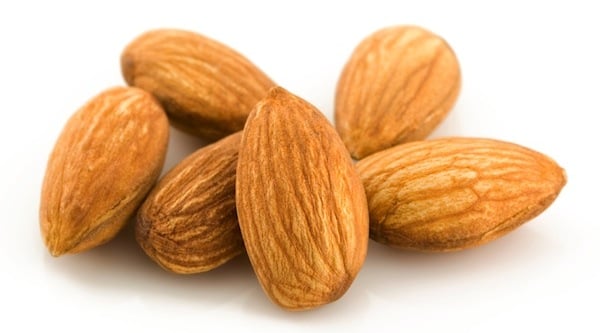>> Think you know nuts? Take our quiz to find out your nut IQ!
“It’s hard to believe nuts had such a bad rap during the low-fat craze,” says Thomas Sherman, an associate professor of physiology at Georgetown University Medical Center. “They’re really so good for you.”
Although nuts are high in calories and fat, he says, a few a day can go a long way when it comes to heart health. The key is understanding the difference between good fats and bad ones. Bad, or saturated, fats are stored in fat cells and used as energy sources. They mainly come from animal products, such as butter, cheese, milk, and fatty meats. Too much saturated fat can mean high blood pressure and an increased risk of heart disease.
Unsaturated fats are the good ones. They include mono- and polyunsaturated fats, which are found in plant-based oils such as sesame, soy, and olive. They’re also—you guessed it—found in nuts. These kinds of fats have been shown to lower cholesterol, decreasing the risk of heart disease, and they help control blood-sugar levels.
Like most foods, nuts contain a combination of good and bad fats, so it’s helpful to know which have the best good-to-bad-fat ratios. Walnuts, says Sherman, are very high in polyunsaturated fat and low in saturated fat, while Brazil and macadamia nuts are just the opposite.
Nuts bring other nutrients to the table, too, Sherman says, so “the key is to mix and match to get the best overall health benefits.” Hazelnuts are low in saturated fat and high in fiber, while almonds have lots of vitamin E, calcium, and iron. Pine nuts are high in vitamin K and zinc, and pistachios are a good source of thiamin, which helps with muscle function.
Sherman’s favorite nut is the walnut, in large part because it has the most polyunsaturated fat of all nuts. A one-ounce serving (about 14 halves) has 13.4 grams of polyunsaturated fat and just 1.7 grams of saturated fat—an excellent good-to-bad-fat ratio. Of course, he also likes the taste—he uses it in a lot of recipes, including his homemade granola (recipe below).
Although you can eat nuts anytime, Sherman recommends munching a few at breakfast. “The American breakfast is carbohydrate-rich, which means you’re going to be hungry again very soon,” he says. “Why not sprinkle some nuts on your oatmeal or add them to your cereal? You’ll get your serving of nuts in and, thanks to all that fiber and protein, you aren’t going to be hungry again until lunchtime.”
Portion size is tricky. Because nuts vary in calorie and fat content, you should select which ones you’ll eat—and how many—within the context of your dietary goals. Most experts advise eating an ounce or two of nuts a day, but Sherman says to remember that in most cases, a little goes a long way.
“At the end of the day, you should see that your total fat intake includes mainly unsaturated fat and very little saturated fat,” he says. “Eating a handful of the right kinds of nuts can help you meet that goal.”
Pining for some good nut recipes? Sherman shares some of his favorites below.
Tom’s Give Peace a Chance Granola
5 cups rolled oats
2 cups chopped walnuts
1 cup chopped pecans
1 cup blanched slivered almonds
1 cup sesame seeds (optional)
1 cup unsalted sunflower seeds
1 cup golden flaxseed or chia seeds
2 cups unsweetened shredded coconut
1 cup wheat germ
1 cup canola oil
1 to 1½ cups honey, depending on how sweet you want it to be
2 to 3 cups mixed dried fruit, such as raisins, dried cranberries, dried blueberries, and dried cherries
½ to 1 cup flax meal (optional)
Preheat the oven to 325 degrees, and position the racks in the upper and lower-middle positions. In a large bowl, stir together the oats, almonds, walnuts, pecans, sesame seeds (if using), wheat germ, coconut, sunflower seeds, and flax seed. In a small pan over medium heat, stir together the oil and honey. Heat and stir until thinned. Pour over the oat mixture, and stir thoroughly to coat evenly; the mixture will be quite wet. Spread in even layers on two rimmed baking sheets.
Bake for 40 minutes until toasted, stirring and scraping the pans every 10 minutes, switching pans between lower and upper racks. Stir in the dried fruit and flax meal (if adding) while still hot from the oven. Let stand until completely cooled, stirring occasionally to break up large clusters. Store frozen in quart-size zip-lock bags.
Curried Cashew Soup
1½ tablespoons canola oil
2 large onions, chopped
3 to 4 garlic cloves, minced
1 large celery stalk, diced
1 cup toasted cashew pieces
1 teaspoon minced fresh ginger
5 cups water, divided
2 teaspoons good-quality curry powder (garam masala is a great alternative to curry powder)
1 tablespoon lemon juice
Juice of 1 fresh orange
3 cups steamed fresh green vegetables, such as finely chopped broccoli, bok choy, or diced zucchini
Salt to taste
Finely sliced scallions for garnish
Chopped cashews for garnish (optional)
In a skillet set over medium heat, cook the oil until shimmering. Add the onion, garlic, and celery, and sauté until lightly browned; remove from heat. Place the cashews in a food processor and process with short pulses until finely ground without forming a butter. Add the onion mixture from the skillet, ginger, and 1 cup of water. Process until well puréed. Transfer the mixture into a large soup pot along with the rest of the water, the curry powder or garam masala, and lemon and orange juices. Bring to a simmer, and heat gently over low heat for 30 minutes. Remove from heat and let stand for 30 minutes to an hour. Return to medium heat. Add the steamed vegetables and adjust if necessary with more water to achieve a slightly thick consistency. Season to taste with salt, and serve once the soup is hot. Garnish each serving with a sprinkling of scallion and a few chopped cashews.
Subscribe to Washingtonian
Follow Washingtonian on Twitter
More >> Health | Top Doctors | Well+Being Blog


















